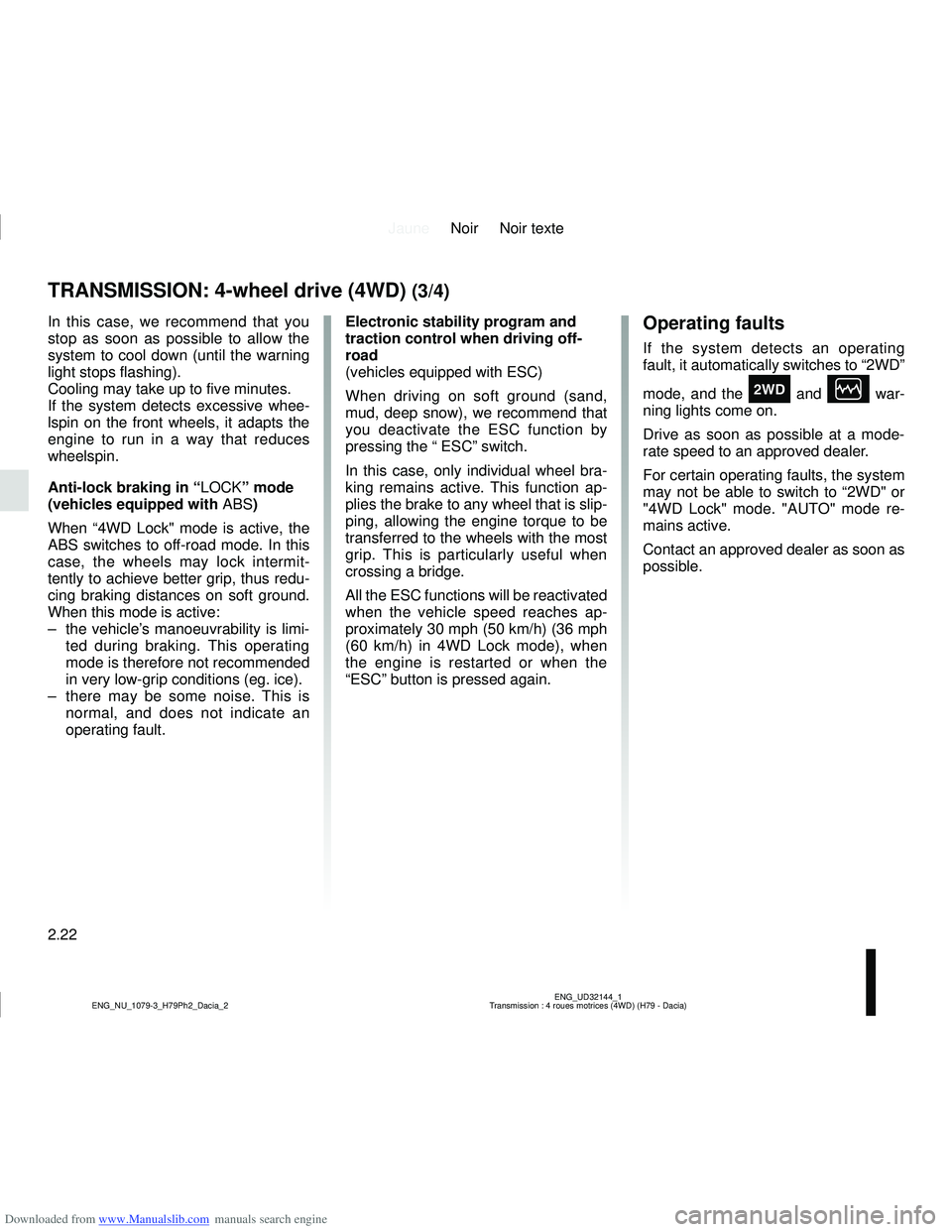Page 99 of 244

Downloaded from www.Manualslib.com manuals search engine JauneNoir Noir texte
2.17
ENG_UD34956_1
Avertisseur de perte de pression des pneumatique (H79 Ph2 - Dacia)
ENG_NU_1079-3_H79Ph2_Dacia_2
TYRE PRESSURE LOSS WARNING (2/3)
With the engine stopped:
– repeatedly press the button 3 to
select “SEt tP” on the display 2;
– press and hold (around 3 seconds) button 3 to start initialisation. “SEt tP”
flashes then comes on steady.
When “SEt tP” disappears, the stan-
dard tyre pressure is saved.
Reinitialisation is carried out after a few
minutes’ driving. Note:
The standard tyre pressure cannot be
less than that recommended and indi-
cated on the door frame.
Check tyre pressure
The warning light
� comes on (not
flashing). This indicates that at least
one tyre is flat.
Check and, if necessary, readjust the
pressures of the four wheels when cold.
The warning light
� goes off after a
few minutes’ driving.
Puncture
The warning light � and the red
warning light
Ò light up on the ins-
trument panel, alongside a beep.
This indicates that at least one wheel
is punctured or severely underinflated.
Replace it or contact an authorised
dealer if it is punctured. Top up the tyre
pressure if the wheel is deflated.
Check tyre sensors
The warning light
� flashes for
several seconds, then stays on, along
with the orange warning light
Ò.
This indicates that the sensor on at
least one wheel is missing or faulty.
The sudden loss of pressure in a
tyre (burst tyre, etc.) cannot be de-
tected by the system.
2
3
The red warning light Ò
requires you to stop imme-
diately, for your own safety,
as soon as traffic conditions allow.
Page 104 of 244

Downloaded from www.Manualslib.com manuals search engine JauneNoir Noir texte
2.22
ENG_UD32144_1
Transmission : 4 roues motrices (4WD) (H79 - Dacia)
ENG_NU_1079-3_H79Ph2_Dacia_2
TRANSMISSION: 4-wheel drive (4WD) (3/4)
Electronic stability program and
traction control when driving off-
road
(vehicles equipped with ESC)
When driving on soft ground (sand,
mud, deep snow), we recommend that
you deactivate the ESC function by
pressing the “ ESC” switch.
In this case, only individual wheel bra-
king remains active. This function ap-
plies the brake to any wheel that is slip-
ping, allowing the engine torque to be
transferred to the wheels with the most
grip. This is particularly useful when
crossing a bridge.
All the ESC functions will be reactivated
when the vehicle speed reaches ap-
proximately 30 mph (50 km/h) (36 mph
(60 km/h) in 4WD Lock mode), when
the engine is restarted or when the
“ESC” button is pressed again.Operating faults
If the system detects an operating
fault, it automatically switches to “2WD”
mode, and the
‘ and Ò war-
ning lights come on.
Drive as soon as possible at a mode-
rate speed to an approved dealer.
For certain operating faults, the system
may not be able to switch to “2WD" or
"4WD Lock" mode. "AUTO" mode re-
mains active.
Contact an approved dealer as soon as
possible.
In this case, we recommend that you
stop as soon as possible to allow the
system to cool down (until the warning
light stops flashing).
Cooling may take up to five minutes.
If the system detects excessive whee-
lspin on the front wheels, it adapts the
engine to run in a way that reduces
wheelspin.
Anti-lock braking in “
LOCK” mode
(vehicles equipped with ABS)
When “4WD Lock" mode is active, the
ABS switches to off-road mode. In this
case, the wheels may lock intermit-
tently to achieve better grip, thus redu-
cing braking distances on soft ground.
When this mode is active:
– the vehicle’s manoeuvrability is limi- ted during braking. This operating
mode is therefore not recommended
in very low-grip conditions (eg. ice).
– there may be some noise. This is normal, and does not indicate an
operating fault.
Page 119 of 244

Downloaded from www.Manualslib.com manuals search engine JauneNoir Noir texte
2.37
ENG_UD33904_1
Boîte de vitesses automatique (H79 Ph2 - Dacia)
ENG_NU_1079-3_H79Ph2_Dacia_2
AUTOMATIC TRANSMISSION (3/3)
– If the road contour and bends in
the road do not allow you to stay in
automatic mode (e.g.: in mountain-
ous areas), it is recommended that
you switch to manual mode.
This will prevent the automatic gear-
box from changing gears repeatedly
when climbing, and permit engine
braking on long descents.
– In cold weather, start the engine
and wait a few seconds before
moving the selector lever from posi-
tion P or N and engaging it in D or R
to prevent the engine stalling.
– Vehicles not fitted with traction
control: on a slippery surface or
surface with a low level of adhesion,
change to manual mode and select
second gear (or even third) before
starting the engine to avoid wheel-
spin when accelerating.Parking the vehicleWhen the vehicle is stopped, move the
lever to position P while keeping your
foot on the brake pedal: the gearbox is
in neutral and the drive wheels are me-
chanically locked by the driveshaft.
Apply the handbrake.
Operating faults
If a vehicle with an automatic gear-
box breaks down, please refer to the
information on “Towing” in Section 5.
When setting off, if the lever is locked
in position P when you are pressing the
brake pedal, the lever can be released
manually. To do this, unclip the base of
the lever, and press recess 7 and the
unlocking button 2 simultaneously.
In very cold weather, the system
may prevent the gears from being
shifted in manual mode until the
gearbox reaches the right tempera-
ture.
An impact to the under-
side of the vehicle while
manoeuvring (e.g.: strik-
ing a post, raised kerb or
other street furniture) may result in
damage to the vehicle (e.g.: defor-
mation of an axle).
To avoid any risk of accident, have
your vehicle checked by an ap-
proved Dealer.
For safety reasons, do not
switch off the ignition before
the vehicle has come to a
complete standstill.
2
7